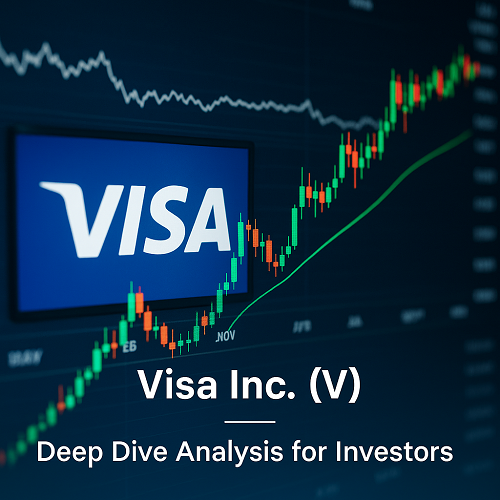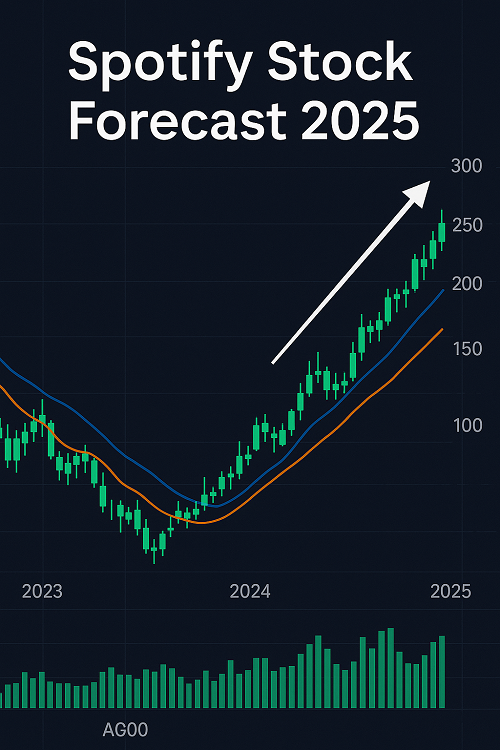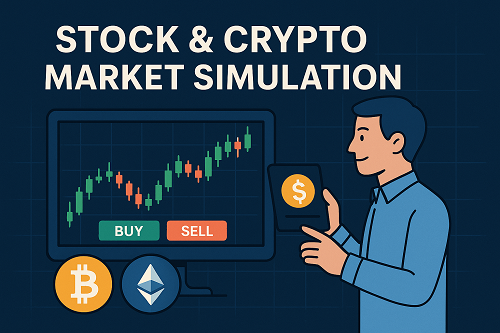Visa Inc., listed as NYSE V, is a global payments‐technology company that enables money movements between consumers, merchants, financial institutions, and governments — primarily through its network branded “Visa”.
Key Details
- Founded (via predecessor) in 1958 and reorganised into Visa Inc. ahead of its 2008 IPO.
- Headquartered in San Francisco, California (Mission Bay).
- Operates in more than 200 countries and territories.
- Uses a business model based on transaction processing: rather than issuing cards directly, Visa provides the “rails” (authorization, clearing, settlement) to banks and merchants.
Business Model Highlights
- Revenue is derived from transaction volume, number of processed transactions, and value‐added services (data, analytics, fraud prevention).
- Because Visa doesn’t take on credit risk (unlike card‐issuing banks), its model is asset-light and relatively scalable.
Why this matters
This model gives Visa:
- High operating leverage (more transactions → relatively lower incremental cost)
- Global scale economies (the network effect improves value)
- Exposure to secular shifts (e-commerce growth, contactless payments, digital wallets)
Market Position & Competitive Landscape
Visa operates in a competitive but structurally advantaged space. Some key points:
Dominant Network
- Visa’s network (VisaNet) is capable of providing transaction authorization, clearing and settlement at massive scale in real time.
- The company has a “moated” business because of network effects: merchants want to accept cards that consumers use, banks want cards that have wide merchant acceptance.
Main Competitors
- Mastercard Incorporated (MA) — another global card network.
- American Express Company (AXP) — more issuer/processor hybrid.
- Fintech disruptors (e.g., PayPal, digital wallets, BNPL) though they often still route over major networks.
Competitive Advantages
- Global brand recognition and acceptance.
- Strong infrastructure investment and risk/security capabilities.
- Ability to expand into adjacent areas (value-added services, tokenization, mobile wallets) to generate higher-margin revenue.
Threats to keep in mind
- Regulatory scrutiny of interchange fees and network practices. (Visa has faced antitrust investigations. )
- Disintermediation risk: if alternate payment rails (crypto, open‐banking, fintech platforms) gain traction.
- Global macro risks (economic slowdowns, cross‐border flows weakening).
Recent Financial Performance & Key Metrics
Here we summarise recent performance, key ratios and what to watch.
Growth & Fundamentals
- According to CSI Market, Visa’s revenue grew ~14.3 % in Q3 2025 year-over-year; net income rose ~8.2 %.
- The Guru Fundamental Report assigns Visa a strong rating (94 %) based on fundamentals and valuation.
- Analysts’ consensus price target ~US$392.75, implying ~13 % upside from current ~US$347.34.
Strategic Metrics
- “Other revenue” (value-added services such as risk consulting, APIs) is growing ~24 % YoY in some recent quarters.
- Free cash flow remains strong, with significant returns to shareholders via dividends and buybacks.
Valuation Metrics
- Forward P/E, PEG, Price-to-Book levels are elevated compared to industry peers, indicating premium valuation built into the stock.
What to monitor
- Payment volume growth (both domestic and international)
- Margin expansion/increase in higher‐margin services
- Buyback & dividend policy (capital return)
- Impact of regulatory or competitive headwinds
Growth Drivers & Strategic Initiatives
What is driving Visa’s growth this decade? Here are the key levers:
Secular Tailwinds
- Digital payments adoption – As more commerce shifts online or to contactless, Visa is positioned to benefit.
- International expansion – Faster growth often comes from non-US markets and cross-border flows.
- Value-added services – Tokenization, fraud prevention, data services create higher margins.
- Embedded payments & fintech partnerships – Visa is increasingly embedding its infrastructure into non‐traditional platforms (e.g., mobile wallets, commerce platforms).
Strategic Moves
- Visa has provisioned 11.5 billion network tokens (as of Sept 30 2024) to support tokenization and digital wallet use.
- The company opened its first dedicated data centre in Africa (Johannesburg) as part of a multi-year ~$1 billion investment across the continent.
- Visa launched a new scam-detection initiative to combat online fraud, investing in AI/automation to protect its network.
Why this matters
These initiatives strengthen Visa’s moat, increase customer stickiness, diversify revenue streams and position the company to capture growth beyond pure transaction volume increases.
Risks and Headwinds
No company is without risks. For Visa, key risk factors include:
Regulatory & Legal Risk
Visa has faced, and may continue to face, regulatory scrutiny over interchange fees and network practices.
Competitive Threats
- Rapid growth of alternative payments rails (cryptocurrency, open bank APIs) may erode margin or market share.
- Fintechs may cut out traditional networks or negotiate lower fees.
Macro & Volume Risk
- A global economic slowdown reduces consumer spending and transaction volume.
- Currency fluctuations and geopolitical issues impact cross‐border flows.
- Both consumer card spending and business spending could decline in a recession environment.
Valuation Risk
Given Visa’s premium valuation, a mis-step (slower growth, regulatory blow, margin compression) could lead to significant share-price downside.
Valuation, Forecasts & Price Target
Analyst Consensus
- Average 12-month price target ≈ US$392.75, roughly 13% upside from current levels.
- Some bullish forecasts extend toward US$450 in a best‐case scenario.
My View & Scenario Analysis
| Scenario | Description | Implied Stock Outcome* |
|---|---|---|
| Base Case | 10–13 % volume growth, modest margin expansion, no major regulatory setbacks | ~US$380-400 |
| Bull Case | 15 %+ growth, rapid adoption of embedded payments, margin gains, positive regulation | ~US$420-450+ |
| Bear Case | Growth slows to 5–7 %, regulatory costs increase, margin compresses | ~US$300-330 |
*Assumes current price ~US$347 and P/E multiple holds reasonably stable.
Key Valuation Metrics to Monitor
- Forward P/E ratio
- PEG (Price/Earnings to Growth)
- Free cash flow yield
- Return on equity (ROE)
- Dividend yield + buyback impact
Conclusion on Valuation
Visa appears fairly priced for the next few years under the base case, with modest upside if the company executes well. Given its premium valuation, the margin for error is smaller, so investor expectations should be tempered accordingly.
Key Takeaways for Investors
- Visa is a high-quality business: global scale, strong network effects, recurring revenue from payments infrastructure.
- Growth is present, but much is priced in: the stock trades at a premium relative to peers and the broader market.
- Execution on value-added services and international expansion will be critical to drive upside.
- Risks (regulatory, competitive, macro) are meaningful given the elevated valuation.
- For long-term investors who believe in the secular payments trend, Visa offers a compelling option — but at current prices it may require patience to earn significant upside.
- For traders or shorter-term investors, catalysts such as new partnerships, regulatory resolution or accelerated embedded payments growth may drive outperformance.
Frequently Asked Questions (FAQ)
Q1: Does Visa issue credit cards?
No. Visa does not issue cards directly to consumers nor does it extend credit. It partners with banks and financial institutions who issue cards under the Visa brand.
Q2: How does Visa make money?
Visa earns revenue from transaction processing fees, service fees, international (cross-border) fees, and value-added services such as fraud prevention, analytics and tokenization.
Q3: What is the biggest growth driver for Visa right now?
Among several drivers, growth in digital payments, tokenization, embedded finance, and international expansion (especially in emerging markets) stand out. These help the company grow both volume and higher-margin services.
Q4: Is Visa a good dividend stock?
Visa does pay a dividend and engages in share buybacks, but it is primarily valued as a growth/quality company rather than a high-yield income stock. Investors should assess dividend yield in context of growth and valuation.
Q5: What valuation multiple is fair for Visa?
Given Visa’s premium business model, a forward P/E in the high 20s to mid 30s may be justified in the base case, assuming healthy growth. However, the multiple compressing could be a risk if growth slows. For instance, some recent reports show Visa trades at far above sector median.
Final Word
Visa stands as one of the most structurally advantaged players in the global payments ecosystem. For long-term investors who believe digital payments continuity and expansion will persist, Visa offers a strong anchor position. However, given its premium valuation and compressed margin for error, the potential reward may be moderate unless the company delivers on its ambitious growth initiatives. As always, any investment decision should be based on your risk tolerance, investment horizon, and portfolio strategy.





 XAUT-USD
XAUT-USD  AMD
AMD  MARA
MARA  SHOP
SHOP  BULL
BULL  CL=F
CL=F